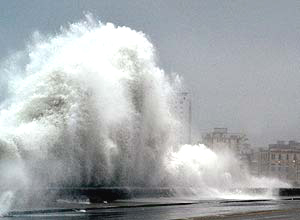Gustav slammed into Cuba's tobacco-growing western tip as a monstrous Category 4 hurricane Saturday while both Cubans and Americans scrambled to flee the storm as it roared toward the oil-rich Gulf of Mexico and New Orleans.
Forecasters said Gustav was just short of becoming a top-scale Category 5 hurricane as it hit Cuba's mainland after roaring over its Isla de Juventud province, where it toppled telephone poles, mango and almond trees and peeled back the tin roofs of homes.
Isla de Juventud civil defense chief Ana Isla said there were "many people injured" on the island south of mainland Cuba, but no reports of deaths. She said nearly all its roads were washed out and that some regions were heavily flooded.
"It's been very difficult here," she said on state television.
Authorities evacuated at least 240,000 people from western Cuba, including Isla de la Juventud.
Gustav was projected to plow into the Gulf of Mexico at full force Sunday, and reach the U.S. coast Monday afternoon. A hurricane watch was issued from Texas east to Florida.
More than a million Americans made wary by Hurricane Katrina took buses, trains, planes and cars as they streamed out of New Orleans and other coastal cities, where Katrina killed about 1,600 people in 2005.
Gustav already has killed 81 people by triggering floods and landslides in other Caribbean nations.
The U.S. National Hurricane Center said Gustav had sustained winds of 150 mph (240 kph), and could become a Category 5 hurricane shortly, with winds above 155 mph (249 kph).
Cuba's top meteorologist, Jose Rubiera, said the hurricane's massive center made landfall in mainland Cuba near the community of Los Palacios in Pinar del Rio - a region that produces much of Cuba's famed tobacco.
He said the storm would bring hurricane-force winds to much of the western part of Havana, Cuba's capital, where power was knocked out as shrieking winds blasted sheets of rain sideways though the streets and whipped angry waves against the famed seaside Malecon boulevard.
Felled tree branches and large chunks of muddy earth littered crowded roads.
Cuba grounded all domestic flights and halted all buses and trains to and from Havana, where some shuttered stores had hand-scrawled "closed for evacuation" signs plastered to their doors.
Authorities boarded up banks, restaurants and hotels, and residents nailed bits of plywood to the windows and doors of their houses and apartments.
"It's very big and we've got to get ready for what's coming," said Jesus Hernandez, a 60-year-old retiree who was using an electric drill to reinforce the roof of his rickety front porch.
The government announced it was stepping up emergency production of bread at state-run bakeries and lines formed all over the city as Cubans waited for loaves.
In tourist-friendly Old Havana, heavy winds and rain battered crumbling historic buildings. There were no immediate reports of major damage, but a scaffolding erected against a building adjacent to the Plaza de Armas was leaning at a dangerous angle.
Lidia Morral and her husband were visiting Cuba from Barcelona. She said Gustav forced officials to close the beaches the couple wanted to visit in Santiago, on the island's eastern tip. The storm also prevented them from catching a ferry from Havana to the Isla de la Juventud on Saturday.
"It's been following us all over Cuba, ruining our vacation," said Morral, who was in line at a travel agency, trying to make other plans. "They have closed everything, hotels, restaurants, bars, museums. There's not much to do but wait."
On Cuba's Isla de Juventud, Gustav toppled trees and was peeling back the roofs of some houses on Saturday.
"The rain is not so intense, but there is a lot, a lot of wind," said Isabel Alarcon from Nueva Gerona, the largest city on the island of 87,000 people. "The officials, they have told us the wind will be bad first but then the rain could cause flooding into the night."
By late Saturday afternoon, Gustav was about 80 miles (135 kilometers) south-southwest of Havana and it was moving northwest near 15 mph (24 kph).
Hurricane force winds extended out 70 miles (110 kilometers) in some places.
The U.S. naval base at Guantanamo, Cuba, was hundreds of miles (kilometers) to the east, out of the storm's path.
In the Gulf of Mexico, where about 35,000 people work staffing offshore rigs and production facilities, among other tasks, oil companies wrapped up evacuations in preparation for the storm.
As of midday Saturday, more than three-fourths of the Gulf's oil production and nearly 40 percent of its natural gas output had been shut down, according to the U.S. Minerals Management Service, which oversees offshore activity.
The U.S. Gulf Coast accounts for about 25 percent of domestic oil production and 15 percent of natural gas output, according to the MMS. The Gulf Coast also is home to nearly half the nation's refining capacity.
Analysts say prolonged supply disruptions could cause a sudden price uptick for gasoline and other petroleum products.
On Friday, Gustav rolled over the Cayman Islands with fierce winds that tore down trees and power lines while destroying docks and tossing boats ashore, but there was little major damage and no deaths were reported.
Haiti's Interior Ministry on Saturday raised the hurricane death toll there to 66 from 59 and Jamaica raised its count to seven from four. Gustav also killed eight people in the Dominican Republic early in the week.
Meanwhile, the hurricane center said Tropical Storm Hanna was projected to near the Turks and Caicos Islands late Sunday or on Monday, then curl through the Bahamas by early next week before possibly threatening Cuba.
As it spun over open waters, Hanna had sustained winds near 50 mph (85 kph) late Saturday afternoon and the hurricane center warned that it could kick up dangerous rip currents along parts of the southeastern U.S. coast, AP reported.






